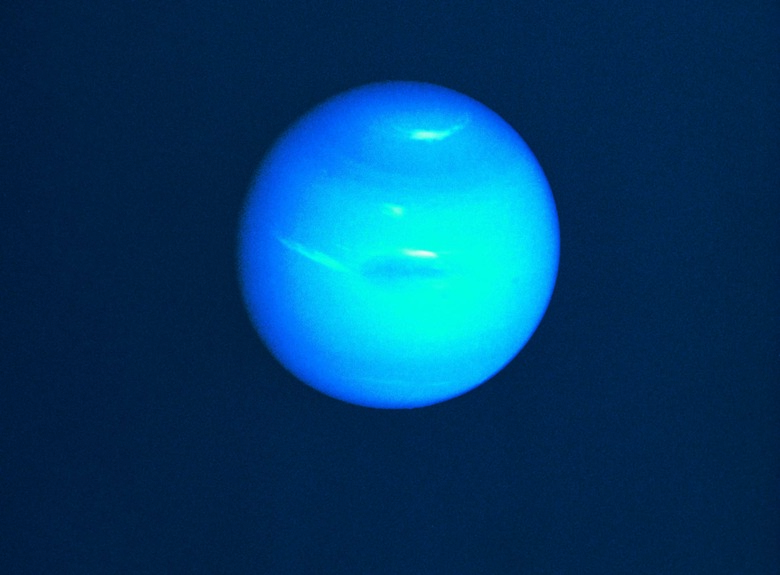Geology Facts On Neptune
Neptune is the solar system's most distant planet from the sun. When Italian astronomer Galileo Galilei first observed Neptune through his telescope in 1612, he believed it was a fixed star. In 1846, German astronomer Johann Galle understood it was a planet. The Voyager 2 spacecraft flew by Neptune in August 1989, and the Hubble Space Telescope has been taking images of Neptune since 1994.
Atmosphere
Atmosphere
Neptune's blue color derives from methane and another as-yet-unidentified component in its atmosphere. Most of the atmosphere is hydrogen, helium and ammonia, with only traces of methane. There are white clouds that could be methane ice. The cloud temperature ranges from -150 to -200 Celsius (-240 to -330 degrees Fahrenheit). Cloud density varies around the planet, producing bands of light blue where the clouds are densest and a darker blue where the cloud cover is sparse. The Voyager 2 spacecraft, and later, the Hubble Space Telescope observed shifting dark spots in Neptune's atmosphere.
Weather Patterns
Weather Patterns
Neptune's dark spots may be huge storm systems. The "Great Dark Spot," first seen by Voyager 2 in Neptune's southern hemisphere, was large enough to hold the Earth. These dark spots and the white clouds are blown around by winds reaching speeds of 1,370 mph. These are the strongest winds in the solar system — nine times as strong as winds on Earth. Voyager 2 observed the Great Dark Spot shift westward at almost 750 miles per hour. This spot was no longer visible in the southern hemisphere on images taken by the Hubble Space Telescope in 2011. Instead, Hubble images showed new dark spots in Neptune's northern hemisphere.
Magnetosphere
Magnetosphere
Voyager 2 detected a magnetic field or magnetosphere around Neptune. It is 25 times stronger than that of Earth and seems to be centered closer to Neptune's cloud tops than its center, as is the case with the Earth's magnetic field. Neptune's magnetic field axis is tilted at 47 degrees to its rotational axis.
Internal Structure
Internal Structure
Astrophysicists speculate that Neptune is mostly gas with a rocky core the size of Earth at its center. The gas becomes highly compressed within Neptune's interior, behaves like a liquid, and conducts electricity. As Neptune spins on its axis, materials in Neptune's interior behave like a dynamo and generate the magnetic field. Neptune may be slowly shrinking and releasing heat in the process. This heat could drive the planet's weather systems.
Moons
Moons
Neptune has 13 moons. All but the largest, Triton, orbit around it in the same direction as the planet's rotation. Scientists believe that Triton is an ice body from beyond Neptune's orbit that was captured by Neptune's gravitational field. It is composed of frozen nitrogen, water and methane. Geysers of nitrogen erupt from its surface and create its nitrogen atmosphere.
Rings
Rings
Six narrow rings of small particles orbit around Neptune. They are not uniform around the planet but appear like clumps of dust shaped into arcs. Scientists speculate that the rings may be minute particles of methane ice that are darkened by the sun's radiation.
Cite This Article
MLA
Kielmas, Maria. "Geology Facts On Neptune" sciencing.com, https://www.sciencing.com/geology-neptune-3200/. 24 April 2017.
APA
Kielmas, Maria. (2017, April 24). Geology Facts On Neptune. sciencing.com. Retrieved from https://www.sciencing.com/geology-neptune-3200/
Chicago
Kielmas, Maria. Geology Facts On Neptune last modified August 30, 2022. https://www.sciencing.com/geology-neptune-3200/
